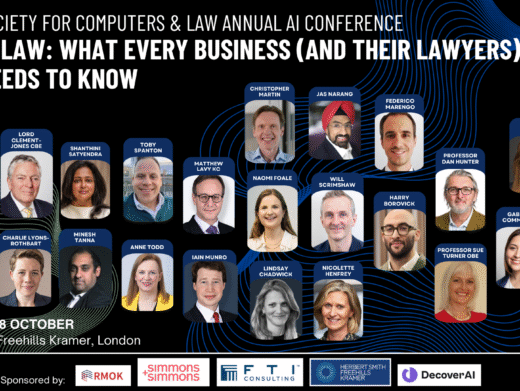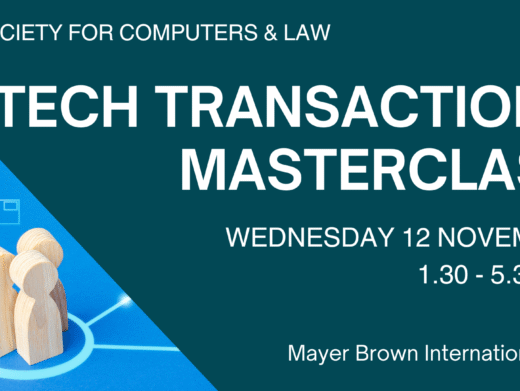1. Introduction
When thinking about my lecture for this evening my mind first went to the judgment of Sir Robert Megarry VC, who, in Ross v Caunters [1979] 3 All ER 580, referred to himself as an equity lawyer cast “adrift on the limitless seas of the common law”. Tonight I am a common lawyer cast adrift on the sea of technology because, as you will quickly realise, I do not profess to be a specialist in computer law. I specialise in contract law, and what I aim to do this evening is look at some of the legal questions which are posed for the law of contract by the use of computers. At the outset, I think it is important to distinguish two groups of cases. The first relates to contracts which are made by computer, via a Web site or by e-mail; the second relates to contracts for the provision of computing services. In the latter group of cases, the contract is not necessarily concluded by means of a computer; it may be a standard, written agreement. The questions which arise in these cases relate particularly to the liability of the service provider and the validity of attempts to exclude or restrict that liability.
2. Contracts made by computers
I will start with the first group of cases, those concerning contracts made by computer. In Chwee Kin Keong v Digilandmall.com [2004] SGHC 71, a case which was decided in
“There is no real conundrum as to whether contractual principles apply to Internet contracts. Basic principles of contract law continue to prevail in contracts made on the Internet. However, not all principles will or can apply in the same manner that they apply to traditional paper-based and oral contracts. It is important not to force into a Procrustean bed principles that have to be modified or discarded when considering novel aspects of the Internet.”
The facts of the case were as follows. The defendants were conducting a staff training exercise in the use of their Web site. They wished to make the training as realistic as possible, and so were actually using their own Web site advertisement. Unfortunately, however, things went wrong, and an amendment was made to the Web site which went undetected by the defendants. The change was made in relation to the price of the printers, not the kind of printers that you and I buy in our personal capacity, but heavy-duty printers for commercial use which were generally sold for some S$3,854. As a result of the error, the price advertised on the Web site was reduced to S$66. The amended advertisement was on the Web site for several days, during which time the defendants were successful in selling over 4000 printers. When they discovered their mistake, they immediately removed the advertisement and informed all those who had placed orders that the price was posted in error, and they would not be meeting the orders. Most of the customers accepted that the defendants had made a mistake and it appears that their claims were simply settled, but six plaintiffs refused to go away. The evidence – which, perhaps appropriately, involved e-mail exchanges and text messages sent between the plaintiffs – showed that during the period that the erroneous advertisement was displayed, the plaintiffs were e-mailing one another and pointing out the wonderful bargain which was on offer. The plaintiffs argued that it was contrary to commercial morality for the defendants to refuse to honour their agreements. The defendants, however, refused to supply the printers and they defended the claims brought by the plaintiffs on a number of grounds.
As we will see, the principal question in Chwee Kin Keong was one relating to the impact of the defendants’ mistake on the validity of the contracts concluded with the plaintiffs. One of the issues we must consider is whether genuinely new principles were developed in this case, or whether existing principles were simply applied in a new context. An analogy may perhaps be drawn here with the 19th century, when a whole raft of contract cases arose out of the newly emerging railway industry. However, we now know that the principles established in these cases – particularly concerning the rules relating to the incorporation of terms into contracts – are of general application. I suspect that the situation regarding the computer industry is essentially the same: existing principles are being applied in a new context.
Of course, this process is not always straightforward. For example, does a Web site advertisement amount to an offer, or is it merely an invitation to treat? The judge in Chwee Kin Keong does not, as I read the case, conclusively resolve this issue. He draws on the cases concerning advertisements in newspapers and the display of goods in a shop, but this is just traditional lawyers’ reasoning: lawyers reason incrementally and by analogy with existing categories. Of course, the default rule established by these cases is that an advertisement or display of goods is an invitation to treat, not an offer. However, in Chwee Kin Keong, the judge does not seem to commit himself one way or the other; rather, his general approach is to say that it is a question of ascertaining the intention of the parties. That being the case, Internet traders must word their advertisements carefully. Thus Rajah JC says:
“Historically the common law has recognised, normally in the contractual features pertaining to a display of goods for sale, the goods are not on offer but are said to be an invitation to treat. The prospective buyer has to make an offer to purchase, which is then accepted by the merchant. While this is the general principle for shop displays, it is open to a merchant to offer, by way of an advertisement, the mechanics of a unilateral or bilateral contract. This is essentially a matter of language and intention objectively ascertained.”
Then he proceeded to what is, for our purposes, the important point:
“As with any normal contract, Internet merchants have to be cautious how they present an advertisement since this determines whether the advertisement will be construed as an invitation to treat or a unilateral contract. Loose language may result in inadvertently establishing contractual liability to a much wider range of purchasers than resources permit.”
Presumably, the more specific the wording of the advertisement, the greater the likelihood that it will be construed as an offer. It should be pointed out that one of the factors which worried the judge in Chwee Kin Keong was that there is a difference between sales in a shop and sales over the Internet, in terms of the potential exposure of the seller. The shopkeeper, when he realises that he is out of stock, can easily withdraw his offer, or say to his customers: “There is nothing left here for you to buy.” It is rather more difficult for this to be done over the Internet. This suggests that Rajah JC was reluctant to conclude that an advertisement on the Web can be an offer, so that the default rule is that the advertisement is an invitation to treat. But Rajah JC was careful not to commit himself unequivocally. At the end of the day much will depend on the intention of the parties.
Of greater concern is the question of when the acceptance takes place; in particular, whether or not the postal rule applies. Does acceptance take place on despatch or on receipt? Here, Rajah JC drew on a distinction between contracts concluded over the World Wide Web, as he put it, and contracts concluded by e-mail. Straight purchases off a Web site are instantaneous contracts and so, the judge said, acceptance must take place on receipt. However, he was not convinced that the same is true of contracts concluded by e-mail, because e-mail is not an instantaneous means of communication. In the latter context, therefore, there is an argument for applying the postal rule, so that acceptance is effective on despatch. It should, however, be noted that, despite this argument, Rajah JC seemed to come down in favour of the receipt rule. But, drawing on the Vienna Convention on Sales – to which the
The mistake issue in Chwee Kin Keong is another example of a problem which we are trying to solve by applying age old rules in a new context, but here fewer difficulties are encountered. Rajah JC found that the contract was void on the ground of mistake, because the plaintiffs knew of the defendants’ error and sought to take advantage of it. The law would not allow them to do this; they were not entitled to snatch at a bargain which they knew was not intended (Hartog v Colin and Shields [1939] 3 All ER 566). The plaintiffs tried to argue that they were simply trying to take advantage of a good deal, but as the judge said:
“This is not a case about bargain-hunting, which is a time-honoured and perfectly legitimate pursuit; this is a case about predatory pack-hunting.”
This must be right. The plaintiffs had gone to the trouble of looking on other Web sites to see what the true price of these printers was, and when they discovered that the defendants were advertising them at a ridiculously low price, they bought vast numbers of them in a very short space of time. They had discovered that the defendants’ advertisement really was too good to be true, and they sought to take advantage of it. But there is nothing new about the law’s intervention here; it is a simple case of an established rule being applied in a new context.
Another difficulty which can arise in the context of contracts concluded by computers is whether or not the word “writing” is apt to encompass contracts which are concluded electronically. I do not profess to be an expert on this particular point. My understanding is that the Law Commission thought most legislative provisions, at least these dealing with written contracts, would be interpreted so as to encompass contracts which are concluded electronically. Personally, I am not convinced this will always be so. The current edition of Chitty (29th ed., 2004) uses the example of the provision in the Statute of Frauds which states that guarantees must be evidenced in writing: the editor is not convinced that this requirement can be satisfied by a contract concluded electronically (see paragraph 4-006).
A similar issue may arise in relation to s 3 of the Unfair Contract Terms Act 1977 (‘UCTA’). Section 3(1) is a very important provision as regards the application of UCTA to commercial contracts, because it says:
“This section applies as between contracting parties where one of them deals as consumer or on the other’s written standard terms of business.”
If there are two commercial parties dealing in a core part of their business, UCTA only applies to attempts to exclude liability for breach of contract, leaving aside sale of goods cases, where one is dealing on the other’s written standard terms of business. The question is: what does the phrase “other’s written standard terms of business”, or, more specifically, the word “written”, mean? It is not altogether obvious that it will include contracts concluded electronically. It seems to me that it is a moot point, and it is probably one which is worth fighting. It is worth fighting because if the contract is not written, UCTA has no application to it. Put another way, if you are the defendant, and the validity of your exclusion clause is being challenged, it appears that you may have two grounds of defence: first, UCTA does not apply because the requirements of s 3(1) have not been satisfied; secondly, if the requirements have been satisfied, the clause nevertheless passes the reasonableness test and is therefore valid. This is a simple example of the questions which new forms of technology pose for the law, because UCTA is a piece of legislation which was drafted prior to the widespread practice of concluding contracts electronically. What we have to do is try and adapt the language of the statute to fit the new context.
3. Contracts for Computer Services
The second group of cases deal with contracts for the provision of computing services. There are very few new principles here. The principal issue which arises in these cases is one of containing risk, because the consequential losses which can flow from a breach of contract can dwarf the value of the contract and potentially bankrupt the defendant. For this reason, it is vital to include in the contract a set of provisions which protect the interests of the defendant. This is where exclusion clauses and entire agreement clauses come into play.
I will start by discussing remoteness of damage, partly because that will lead me on to the issue of indirect or consequential losses. It is a rule of law that if the loss is too remote a consequence of the breach, the defendant is not liable for that loss (Hadley v Baxendale (1854) 9 Exch 341). The problem, of course, is that the remoteness rules are rather wide. Professor Atiyah once pointed out (An Introduction to the Law of Contract (5th edn) p. 468) that liability for consequential losses is excluded precisely because the remoteness rules are so liberal; if the remoteness rules were more restricted, we would not need to draft exclusion clauses in the way we do. I think he was right. The remoteness test is traditionally split into two parts. We all know that the loss is recoverable if it flows naturally from the breach; this is often referred to as Hadley v Baxendale, Limb 1. Hadley v Baxendale, Limb 2 applies where the loss does not flow naturally from the breach, but is recoverable because it was within the contemplation of both parties at the time of entry into the contract. This rule puts the onus on the parties to disclose special losses prior to contracting, because if they withhold this information, they may find that they cannot recover in respect of these losses. I want to make two points on the remoteness cases. The first is that the drift of modern authority on remoteness of damage is to collapse the two limbs of Hadley v Baxendale into one test. I will comment on the significance of this below. The second point is best illustrated by a case called Balfour Beatty Construction (Scotland) Ltd v Scottish Power plc 1994 SLT 807, a House of Lords decision on a Scottish appeal. It seems to me that there is sometimes an analogy to be drawn between construction cases and those concerning the provision of computing services. The facts of the case were as follows. Scottish Power provided a temporary electricity power station for Balfour Beatty, who were constructing a bypass around
“It must always be a question of circumstances, what one contracting party is presumed to know about the business activities of the other. No doubt the simpler the activity of the one, the more readily can it be inferred that the other would have reasonable knowledge thereof. However, when the activity of A involves complicated construction or manufacturing techniques, I can see no reason why B who supplies a commodity that A intends to use in the course of those techniques should be assumed, merely because of the order for the commodity, to be aware of the details of all the techniques undertaken by A and the effect thereupon of any failure of or deficiency in that commodity.”
In other words, the mere fact that one party agrees to supply a service or a component for another does not mean that it is thereby fixed with knowledge of that party’s business. In the 19th century cases, knowledge was more readily found, but this must be seen against the background of the simpler business activities in which the parties were generally engaged. In today’s more complex world, sellers or suppliers cannot necessarily be assumed to know the purposes to which their customers are going to put their goods or services. Certain losses are simply too remote a consequence of the breach; if they have not been disclosed prior to contracting, the defendant cannot be liable for them.
Remoteness, then, is an important preliminary issue, because it is only if the loss is prima facie recoverable that we need to consider the possibility of excluding liability for that loss. This takes me on to the next issue, indirect or consequential losses. In Pegler Ltd v Wang (UK) Ltd [2000] BLR 218, a computer case, the following exclusion clause was used:
“Wang shall not in any event be liable for any indirect, special or consequential loss, howsoever arising (including but not limited to loss of anticipated profits or of data).”
The phrase “indirect or consequential loss” is sometimes used as a synonym for loss of profits. This, on the authorities, is clearly wrong. In Pegler v Wang, the drafters of the contract tried to include loss of profits by writing in brackets after “indirect, special or consequential loss”, “including but not limited to loss of anticipated profits”. However, a clause drafted in such terms is doomed to failure because, while it covers “loss of anticipated profits”, it only includes the loss of profits which are also indirect or consequential. It goes without saying that many losses of profit are direct, rather than indirect. So if your aim is to exclude liability for loss of profits, it is advisable to include an express provision to this effect, rather than rely on the vague wrap-up phrase of “indirect or consequential loss”. Of course, you may find that the other party to the contract will not accept an exclusion clause which is drafted in these terms. This then becomes a matter for negotiation. All that can be said is that, if the outcome of the negotiation process is that you finish up with a phrase such as “indirect or consequential loss”, you should realise that your client has not excluded a great deal of its potential liability. This is because the courts have said on a number of occasions that the line between direct and indirect or consequential is to be drawn by reference to the Hadley v Baxendale dichotomy. By using a phrase such as “indirect or consequential loss”, you will only exclude liability incurred under the second limb of the Hadley v Baxendale test; that is, liability for special losses which are recoverable by virtue of the fact that they are in the contemplation of both parties at the time of entry into the contract. You will not exclude liability incurred under the first limb of the test; that is, liability for losses which flow directly from the breach, because the chattel which is the subject-matter of the contract is being used for profit-making purposes.
It is strongly arguable that these pronouncements of the courts are wrong because in the context of remoteness of damage the recent trend has been to collapse the Hadley v Baxendale limbs into one rule, rather than preserve the distinction between the two limbs. It does seem rather odd to impute to the draftsman of a contract an intention to apply the Hadley v Baxendale dichotomy. However, the problem is that the Court of Appeal has confirmed this approach on a number of occasions. In Caledonia North Sea Ltd v British Telecommunications plc [2002] UKHL 4, Lord Hoffmann said that he wished to “reserve the question of whether.the construction adopted by the Court of Appeal was correct”. When it comes to advising a client, this is not very helpful, because all you can say is: if we go all the way to the House of Lords, we may well find that “indirect or consequential loss” does not mean what the Court of Appeal currently says it means, but below this level the courts are bound by this rule of construction. So it seems to me to be unwise to place too much emphasis, or indeed any emphasis, on the phrase “indirect or consequential loss”. Insofar as your aim is to exclude loss of profits, say so expressly and make sure any reference to “loss of profits” is clearly separated from any reference to “indirect or consequential loss”. If you do end up including the phrase “indirect or consequential loss”, realise that your liability could in fact be rather wide.
As regards UCTA, I have already mentioned s 3(1) and its potential application. At first sight, computer companies do not seem to have fared desperately well under UCTA, in the sense that there are a number of computer cases in which limitation clauses have been held to be unreasonable. In St Albans City and District Council v International Computers Ltd [1996] 4 All ER 481, a clause which limited liability to £100,000 was held to be unreasonable; in Salvage Association v CAP Financial Services Ltd [1995] FSR 654, a limitation of £25,000 met the same fate; and in Pegler v Wang, another clause failed to satisfy the reasonableness test. Of course, the fear for computer companies is that, if their clauses are held to be unreasonable, they will be exposed to a claim for the full amount of damages, subject to the (rather liberal) remoteness rules; they will have no other way of protecting themselves. So if they draw the line in the wrong place, they are in trouble.
Do the
What can we conclude about UCTA? There are two points I wish to make. The first is that, when preparing for trial, you should do so on the basis that this is your only opportunity to defend your clause. This is because, although there are cases where the Court of Appeal has intervened and overturned the decision of the trial judge, the ability of an appellate court to intervene in this way is limited. The House of Lords has said that the court should only intervene where the judge’s decision is so unreasonable that it cannot be justified; there must be something akin to Wednesbury unreasonableness (George Mitchell (Chesterhall) Ltd v Finney Lock Seeds Ltd [1983] 2 AC 803). The trial judge therefore has a substantial degree of discretion, so that all your effort in showing that a clause is reasonable or unreasonable must be put in at the trial stage. The way I read the
The second point is that it is important to be able to justify the limitation figure that you choose. It has long been clear that limitation clauses have a greater chance of passing the reasonableness test than total exclusions of liability. However, you must be able to justify the limit that has been chosen. This seems to follow inevitably from the wording of the legislation. UCTA states that the onus of proving reasonableness is on the party seeking to rely on the clause: if you have no idea why you inserted the figure, on what basis can you prove that the clause is reasonable? What the court is looking for is some objective justification based on, for example, the turnover of the party relying on the clause, the insurance cover available, the value of the contract, or the financial risk to which the defendant is exposed. Of course, the value of the contract may not have any great link with the losses which may flow from the breach. But the difficulty is that, once you go above the contract price, where do you draw the line? There may well be no obvious figure to choose once one goes above the contract price. However, I think it is possible to select a figure which is wholly unrelated to the loss but which is nevertheless justifiable. All that is necessary is that you be able to show by a process of negotiation how the figure was arrived at. For example, you started with what you thought was an objectively justifiable figure; the other party started with a much higher figure; by a process of negotiation you came to a figure somewhere in the middle. This seems to me to be an acceptable way of justifying the limitation figure, and thereby proving the reasonableness of the clause. The final figure is a compromise between the conflicting interests of the parties but it was a figure with which both parties felt comfortable and so should provide evidence from which a court can infer that the clause was indeed reasonable.
Before I finish, I wish to make a couple of points about entire agreement clauses. The first is that they do not necessarily work. The second is that they come in different shapes and sizes. In Deepak Fertilisers and Petrochemicals Corporation v ICI Chemicals & Polymers Ltd [1998] 2 Lloyd’s Rep 139, the entire agreement clause was phrased as follows:
“This contract comprises the entire agreement between the parties, as detailed in the various Articles and Annexures and there are not any agreements, understandings, promises or conditions, oral or written, expressed or implied, concerning the subject matter which are not merged into this contract and superseded hereby. This contract may be amended in the future only in writing executed by the parties.”
By comparison, the entire agreement clause in Watford Electronics Ltd v Sanderson CFL Ltd [2001] EWCA Civ 317 was drafted in the following terms:
“The parties agree that these terms and conditions (together with any other terms and conditions expressly incorporated in the Contract) represent the entire agreement between the parties relating to the sale and purchase of the Equipment and that no statement or representations made by either party have been relied upon by the other in agreeing to enter into the Contract.”
A number of points can be made about these entire agreement clauses. The first is that they are most likely to work in the situation where one party is trying to defend itself against a claim that there is some other term of the contract which it has breached. Both clauses above assist the defendant in such a case by stating that the contract is the entire agreement, and there are no other terms. I prefer the Deepak formulation; it is more complete than that used in Watford Electronics.
Secondly, it should be pointed out that entire agreement clauses can also be used in an attempt to eliminate any possible liability for misrepresentation. Some entire agreement clauses try to do this; some do not. The Deepak clause does not – as I read it, it is only concerned with breach of contract claims. The Watford Electronics clause, on the other hand, does try to shield the parties from liability for misrepresentation. The thrust of the clause is to say that there can be no liability for misrepresentation because a misrepresentation is a statement which induces a party to enter into a contract; if you agree not to rely on any statement, there can be no misrepresentation. I am not convinced this approach works because there is potentially an estoppel problem. If I am a seller and I make a statement inviting you to rely on it, it does not seem a very attractive argument to say that, when you do rely, in fact you are not entitled to do so because a clause in the contract says you may not. In many respects, the issue turns on whether the court will give priority to the written terms of the agreement, which stipulate that there will be no reliance, or whether they will give priority to oral statements made by the parties, because if they give priority to the latter the clause will not work. I would certainly be wary about relying on an entire agreement clause to exclude liability in this situation. If you want to exclude liability for misrepresentation, the easiest way to do so is to include an express term to that effect. A term stating something along the lines that “no liability is accepted for any representation” should be effective; although it may be necessary to attach the proviso “other than one made fraudulently”, to make sure the clause is not subject to attack under UCTA. It is questionable whether such a proviso is necessary, but I would include it for reasons of caution; given that you never intend to exclude liability for fraud anyway, you may as well make this explicit rather than leave it to be implied.
The third question is: are entire agreement clauses caught by UCTA? The jury is out on this one. There are some cases which say ‘yes’, and others which say ‘no’. The issue is an easy one to state, but it is harder to resolve. It is a question of form or substance. The form of a no-reliance provision is not that of an exclusion clause. However, as a matter of substance, the effect of such a clause may be to exclude liability for misrepresentation. Given this uncertainty, the answer to the question depends on the task you are undertaking. If you are drafting a contract, you should work on the assumption that UCTA may apply and draft accordingly. If, on the other hand, you are a litigation lawyer, you would not want to concede this particular point, because it is certainly arguable that UCTA has no application.
4. Conclusion
Despite these uncertainties and unanswered questions, I think that, if we look back on all the cases in the second category, we can see that there are few new principles in play; the courts are simply engaged in applying age-old principles in a new context. If there are any new principles, then these are probably to be found in the first group of cases, namely those relating to contracts made by computer; and there, I suspect, you are greater experts on the subject than I am. On that note, I will conclude.
Professor McKendrick is Professor of English Private Law,




